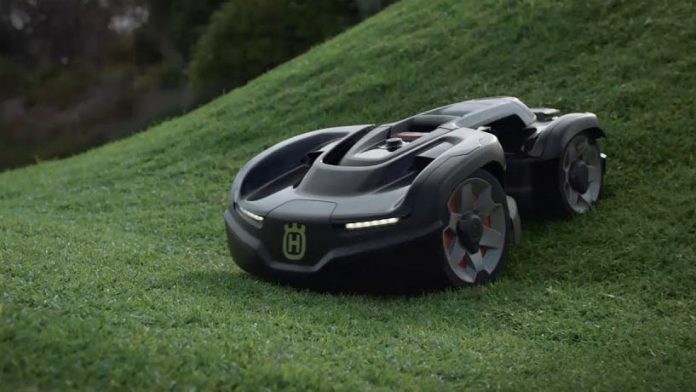
Last year, while attending a turfgrass conference in Copenhagen, I learned about how autonomous mowers were already being used across Europe. Big expensive computers were being attached to big expensive mowers to cut the grass without the need for a human operator.
While this technology was impressive, it wasn’t what caught my attention. The presenter showed how they were using small “roomba” style mowers to essentially achieve the same thing for a much lower cost.
The golf course industry has faced many challenges in the past decade such as labour shortages, rising costs and shrinking budgets. While the expensive computers on expensive mowers are impressive, they don’t yet offer an economical advantage for lower budget golf courses. The smaller “roomba” mowers are a different story, though.
These machines capitalize on all of the advantages that robotic technology can offer. They don’t need to sleep, don’t need days off, don’t get bored, and don’t show up late for work. These characteristics allow mower size to shrink because speed is not a concern. They can slowly plod away, almost silently, mowing for up to 20 hours a day. They need to stop to charge, of course.
The small size offers other advantages, such as less weight, so less chance they get stuck in wet spots. They are also safer for golfers. The large autonomous mowers need human supervisors to ensure that they don’t run anyone or anything over. The small robot mowers only weigh 30lbs and stop working when touched, so are much safer, and thus, require no human supervision. The light weight and low profile also allow the mower to mow incredibly steep slopes with ease.
They also mow differently than traditional mowers. Traditional mowers are expensive and very fast. They require operators to only mow a given area once with minimal overlap from one pass to the other.
The small autonomous mowers are dumb. They mow within their assigned area in an almost random mowing pattern. They brute force the job with their unrelenting persistence. They will mow their given area one to five times a day. They only shave a small amount of grass off with each pass, which requires much less power to do than a traditional mower, which cuts larger amounts of grass with each pass, much less frequently. Shave is the appropriate term because these mowers use small razor blades to cut the grass.
This low energy requirement allows for fully electric operations with relatively inexpensive batteries. In British Columbia, where the majority of our electricity comes from hydro, we see a 99 per cent reduction in greenhouse gas emissions with these mowers, compared to our traditional diesel-hungry machines. Even in areas with the dirtiest power production there is still a 50 per cent reduction in GHG emissions with this technology. (source: asianturfgrass.com/2019-05-02-mowing-electricity-energy)
So, how do these mowers compare costwise? As these mowers can only mow an area the size of the average fairway (1.25 acres), you need to break down your current costs on a per fairway basis. For us out West, we see a 20-50 per cent reduction in mowing costs. The 20 per cent reduction is if we keep our current labour force and direct it to areas other than mowing. The 50 per cent reduction in costs comes if we reduce staff levels further, which is not my preference.
There is, of course, the cost of installing the charging infrastructure across your course. Each mower has a base station that it goes to in order to charge up multiple times each day. This work can be done slowly over time as there is no commitment to use this technology across the entire golf course all at once.
You can slowly build out the charging network over a number of years while extending the life of your current mower fleet in the process. Do you have satellite irrigation controllers? You probably already have the power to charge these mowers across your course.
For my course, we would need 60 of these small machines, which at first sounds crazy, but this would cost about the same as four traditional mowers and the grass would be maintained at the perfect height all the time, rain or shine. Having one type of mower across the entire course would be easier to maintain, and if one machine breaks down, the rest of the course still gets cut. Currently, if our one fairway mower dies, nothing gets cut.
But what do the golfers think? In the past month of use at my course there have been no negative comments from golfers regarding turf quality, although any trained turfgrass professional will notice a slight difference in after-cut appearance. For me, this is not a problem as the robot-mowed fairway is the only fairway where we don’t struggle with clippings, as it gets cut multiple times a day.
While you might think this technology is out of reach and far off, it’s here today and offers huge advantages to the struggling game of golf. While they aren’t perfect, I don’t like “perfect to get in the way of good.”
As this technology quickly evolves, the possibilities are endless. Robot mowers are here!
Jason Haines is the golf course superintendent at Pender Harbour Golf Club in British Columbia, Canada. He is a passionate turfgrass manager with a love for the outdoors and enjoys trying new things and pushing his personal boundaries. Haines achieved a diploma in turfgrass management technology from NAIT (Fairview College). He also received an award from Golf Course Industry magazine in 2014 for Best Blog/Savvy Social Media and was a Merit International Winner for the 2017 Environmental Leaders in Golf Awards. He is an active user of social media (@pendersuper) and has been sharing his ideas about greenkeeping on his blog www.turfhacker.com since 2011.











